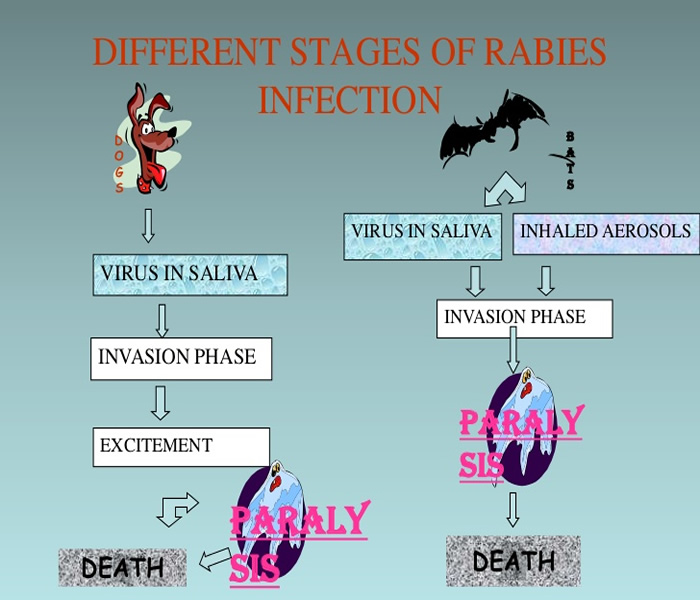What is Rabies Virus?
Is a contagious and fatal viral disease of dogs and other mammals that causes madness and convulsions, transmissible through the saliva to humans. It is a virus that may affect the brain and spinal cord of all mammals.
Also known as an acute viral disease of the central nervous system that affects humans and other mammals but is most common in carnivores (flesh-eaters)
It is sometimes referred to as a Zoonsis, or disease of animals that can be communicated to humans. Rabies is almost exclusively transmitted through saliva from the bite of an infected animal.

What is the Causes Rabies?
- Exposure to the saliva of the infected animal usually through a bite or scratch.
- Having contact with a rabid animal.
- Having contact with material used for infected animal/person.
The initial symptoms of rabies are mild, but they quickly become serious.
- Fever
- Headache
- Feeling generally unwell
- Feeling scared or anxious
- Aggressive Behaviour
- Agitation
- Difficulty swallowing
- Hallucinations
- Hydrophobia (fear and avoidance of water);
- Hypersalivation (Production of a lot of saliva.)

How to diagnose Rabies
- Examination and testing of samples of skin, saliva, and cerebrospinal fluid (obtained by spinal tap)
- A sample of skin is taken (usually from the neck) and examined under a microscope (skin biopsy) to determine whether the virus is present.
- Samples of saliva are also examined to check for the virus.
- A spinal tap (lumbar puncture) is done to obtain a sample of cerebrospinal fluid (the fluid that flows through the tissues that cover the brain and spinal cord). This sample is also examined.
The incubation period
The incubation period for rabies is usually two to 12 weeks, although it can be as short as four days. It is unusual for the incubation period to last for more than a year. i.e the time that it will take before the symptoms show after it has be contacted ranges from two to eight weeks.How to Prevent Rabies
- Avoid contact with animals you don't know.
- Get vaccinated if you work in a high-risk occupation or travel to countries with a high rate of rabies.
- Make sure your pets receive the proper immunizations. Ask your veterinarian.
- Follow quarantine regulations on importing dogs and other mammals in disease-free countries.
There are two types of rabies vaccine injections.
- Injection of the human rabies immune globulin (HRIG) for immediate protection is based on your exact weight. This is not a situation where more is better. Therefore, you should not overestimate your weight. If the exact weight is not known, you will be weighed at the hospital.
- Injection of the vaccine will begin during this initial visit to the emergency department and will proceed on a schedule over the next 14 days, with a total of four small injections.
- HDCV (Human diploid cell vaccines)
- PCECV (Purified chick embryo cell culture vaccine).
Clean the bitten area and bite very thoroughly with water and soap. Once bitten, you should clean the wound thoroughly with a lot of soap and water as soon as possible. Washing the bite right away will lower the chance of infection. The bite with clean water and apply several applications of soap to the wound. Use a disinfectant like povidone-iodine if you have any disinfectant on hand. Pour or dab some disinfectant on to the wound. The disinfectant will kill off the virus before it can infect the person who has been bitten. Most importantly, take a full bath wash the eyes, nose, and mouth if they came into contact with the animal’s saliva, as in some cases, the virus can pass through the mucus membrane of a person’s eye, nose, or mouth.
Take the bitten person to the hospital immediately after cleaning the wound. After you have thoroughly rinsed the bite, take the person to the hospital right away. Once there, tell the nurse and doctor exactly what happened so that proper treatment can begin right away. The doctor will inspect the wound to ensure that it is clean and that there are no signs of bone or tissue damage.
A loose dressing will be applied on top of the wound to prevent any microbes from entering the bite. The wound should not be stitched because this increases the chance of exposing the nerve endings to the virus therefore increasing the chances of being infected. Then a laboratory tests would be conducted to determine whether or not the rabies virus is present. The test would be the skin and saliva of the patient where a specimen is taken to the laboratory for analysis. The doctor will discuss the person’s history to determine the level of contact the person had with the infected animal. This will help in determining the chances of infection and the need for treatment. If the infected person has not taken tetanus injection for a very long time he or she would be asked to take tetanus injection, this of course, is to prevent tetany, another issue that can occur from being bitten by an animal.
Tetanus injections are given on first contact, at 2 months, 3 months, and 4 months, 1 year and after 13-18 years.
Take antibiotics. To keep infection from occurring, the bitten person will be given antibiotics. The most common antibiotic for the prophylaxis treatment of rabies is amoxicillin clavulanate (augmentin).

The augmenting is generally recommended as 1G taken twice a day for 14 days.
Be ready for a series of anti-rabies vaccines if the rabies virus is present. The bitten person will be given an anti-rabies vaccine called (HRIG) Human rabies immune globulin. This shot is injected into the hip and site of the bite for a rapid protection against the rabies infection. The immunoglobulin acts by producing antibodies specifically made to neutralize the virus and stop it from spreading.
These injections are usually given on initial contact with the rabies virus, third day, seventh day, fourteenth day and 28th day. After the shot in the hip and bite site on the first day, the rest of the shots will be injected into the arm.
If the person has already had a rabies vaccine, the person will be given two doses. The first dose will be give on the day the person was bit and then the second dose will be given three to seven days later.
Know that there will be some tenderness where the vaccine gets injected. The bitten person may experience some tenderness, swelling, pain and redness at the injection site. These symptoms usually clear on their own and will generally not last more than 24 hours.
Home Remedies/Home Cure for Rabies
You can ward off infection with the following home remedies for rabies until you have a chance to see a doctor:




